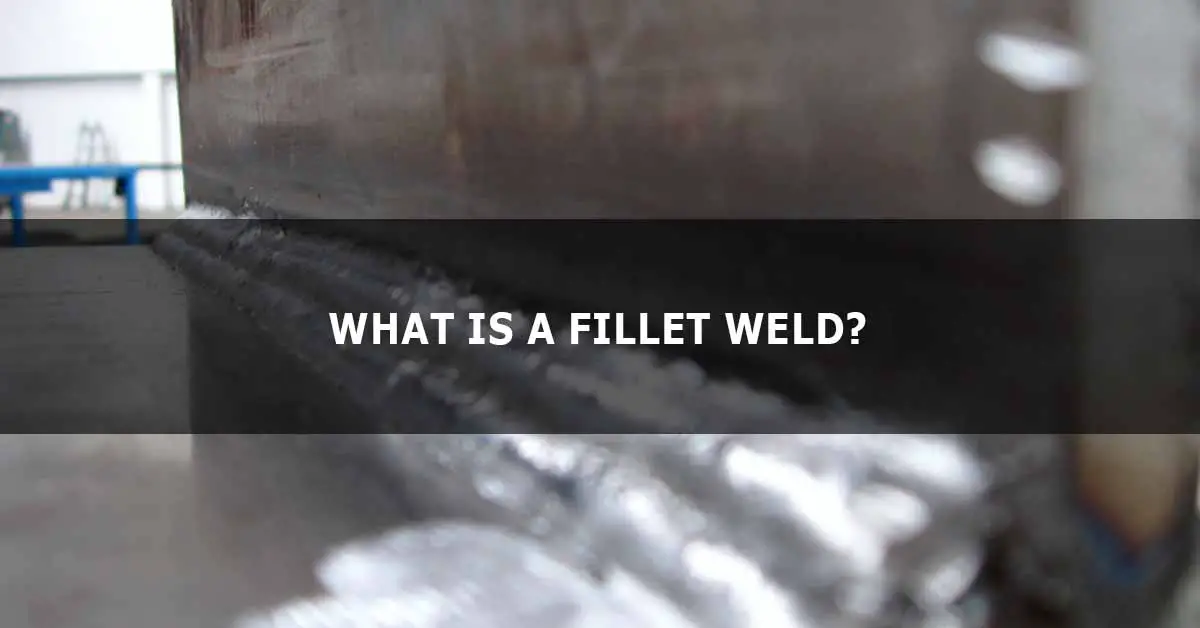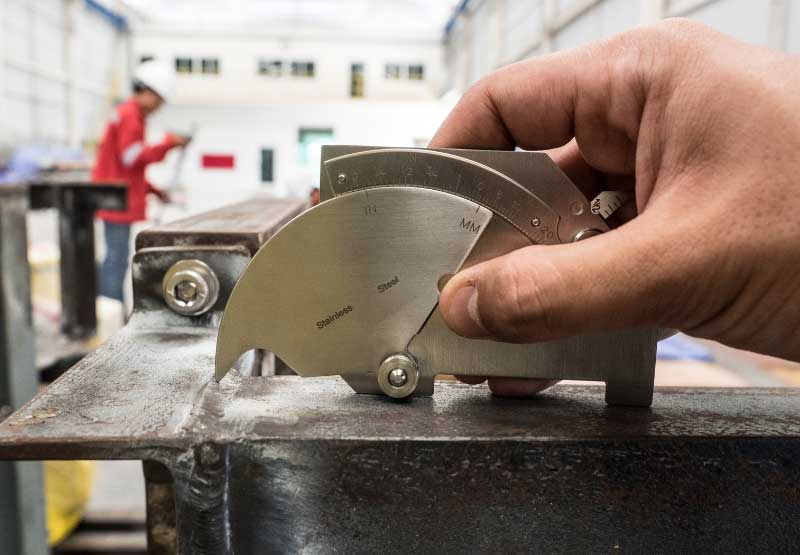Whether you have just picked up welding or are an old grizzly veteran, you will probably hear the term fillet welds tossed around the weld shop very often. A fillet weld is a triangular type of weld used to join two surfaces that are approximately at a right angle towards each other. These types of welds are used to join tee, lap, and corner joints together.
In fact, fillet welds are some of the most commonly used types of joints in welding today. They actually account for a much wider array of fabrication made today than you might think. Therefore, it is important for each welder to know about fillet joints, how to make them, the maximum fillet weld size, and many more surrounding factors. This is what the article is going to talk about today.
Common Fillet Weld Shapes
Three distinct fillet weld shape types are commonly used in fabrication – T joint, lap joint, and corner joint. Some of the most common terms you will hear when creating fillet welds are leg length, throat thickness, and deep penetration throat thickness. Out of these, throat thickness is the hardest one to measure.
It includes parts of the heat-affected zone where the extent is complicated to define precisely. Fillet welds also exist in several different shapes. The most common ones are miter, convex and concave fillet welds.
- Miter – The cross-section of a miter type of weld comes in the form of a right-angled triangle.
- Concave – The shape of the fillet weld is similar to the miter one but comes with a singular difference. Instead of being completely flat, the exposed surface comes in a convex shape. The exposed plane of the weld bends inward, as is the case with a concave lens. The concave fillet weld’s throat thickness is lesser than the miter weld.
- Convex – The exposed surface of the convex filler weld bends outward or in the opposite direction compared to the concave fillet weld. This results in a bigger throat thickness than the miter and concave fillet welds.
How to Prepare a Fillet Joint?
The basic way to start is to clean the metal you are about to work on. One should weld metals not covered in corrosion, grease, paint, or oil. The joint faces must be touching and not bent or twisted to produce large gapping. Removing paint or rust can be done very quickly as all you need is an angle grinder with a mounted grinding wheel or sandpaper. But do not go overboard with grinding, as doing it too much will leave grinding marks or reduce the thickness of the metal you plan to work on.
It goes without saying that proper PPE equipment should be worn at all times when grinding and preparing the joint. Use eye protection, which is specifically rated for grinding, and gloves.
After removing all the rust and paint, you must ensure that the parent material’s edges meet correctly. Be sure to avoid bent or twisted metals and see to it that the two pieces touch.
Using a degreasing agent is also a good idea to remove any remaining grease or oil particles. Degreasing takes only a few minutes as you simply have to wipe the joint face a few times. Be sure to avoid chemical-based solutions and do not use paint thinners. There are many degreasing agents sold commercially, so you will probably be able to find one with ease at your local hardware store.
How to Create a Fillet Weld?
Usually, a fillet weld should have a leg length that is equal to the plate thickness (up to 3/8 inches). If the plate thickness is greater, then a minimum of 3/8-inch leg length will be required for all types of welds.
Using larger wet welding electrodes requires a larger weld metal deposition. However, larger electrodes create more porosity within the deposited weld metal. A larger single pass weld may have a lower toughness even compared to a multipass weld of equal size. This is due to the tempering effect that each of the multipass welds creates on the preceding passes.
Welders should use a 1/8-inch electrode, suitable for most positional work. So to achieve a 3/8-inch leg length, a welder usually has to make around three to five passes. Remember, the number of passes is not as important as the goal is to achieve a 3/8-inch leg length.
In the situation where you happen to be working on thinner metal in an overhead position, a 1/8-inch electrode is also suitable. But using smaller electrodes also means more passes. The succeeding passes will temper the preceding passes, so you should not worry as multipass welding, where a welder uses electrodes with a smaller diameter, results in high-quality wet welds with much better metallurgical properties.
Related Article: Welding Symbols | Guide To Reading Weld Symbols
Potential Problems
Unfortunately, there are going to be some problems that welders could come across while fillet welding. Successfully overcoming them will result in a good weld. But doing the opposite might result in you getting some scrap metal instead.
Potential T-Joint Filet Weld Problems
The most important part of creating a good fillet weld is getting the correct profile dimensions. The leg length and the throat thickness have to be of a specific range for a reliable fillet weld to be created. The designer must compute and create optimal dimensions for the fillet weld profile.
Designers may include a safety factor when creating it, but the weld size will be stated using the appropriate weld symbols. An added safety factor may also be included to reinforce the weld joint. Some people agree that it would be good to expand the leg length to increase strength.
When a designer has added a safety factor within an original weld design, adding another safety factor will create an excessively large weld compared to the one that is actually needed. Oversized welds do not have greater strength than the design. They can also incur higher operational costs, lead to wasteful use of consumables, and lead to additional fabrication issues like distortion.
Potential Lap Joint Fillet Weld Problems
Lap joints are no exception when it comes to oversized welds. The designer may include leg lengths of the same size as material thickness. If you want to add strength, then the fillet weld size need not have the same size as plate thickness, and it actually does not need to be anywhere close to it.
But there are other problems that the weld may also suffer from. For example, the upper corner of the lap joint may melt from welding. It will reduce leg length and cause it to be undersized due to a lower design throat value.
In that case, the welder has to be careful not to melt the upper plate while welding. Ideally, the weld should be placed 0.5mm lower than the top corner of the upper plate. For this to work, the designer has to specify a leg length size similar when compared to the part thickness.
There are additional problems that may occur during fillet weld fabrication. A potential risk lies in the overlap of weld toe due to a bigger weld pool. These defects could reduce the weld joint because of a greater toe angle. A higher toe angle will create stress, weakening the weld much quicker.
Non-destructive testing techniques should not be used on fillet weld joints. This could be problematic due to inspection difficulties, while ultrasonic testing is a bit time-consuming. Also, the results of these tests may not be as easy to interpret.
Non-destructive Testing Techniques for Fillet Welds
Several issues come with magnetic, penetrant, and visual testing. Namely, these techniques scrutinize the surface and are therefore deemed to be superficial in nature. Their biggest drawback is that they are incapable of discerning the weld’s inner structure, nor are they able to find any defects hidden beneath the surface.
Fillet welding is already complex as it is, but so is its inspection. Fabricated fillet welds are, in most cases, much more significant than the original design size ones. Created fillet welds may end up with a poor profile shape, affecting their reliability and durability.
The best way is for welding operators to follow the design weld specifications exactly as shown in the drawing sheet. Welders should also have the skill and the mastery that will allow them to weld a profile by avoiding defects that may arise because of a wrong shape.
Conclusion
Creating a proper fillet weld requires skill and practice. A beginner welder should not start working on it right away. Since various problems may occur, giving a novice welder this kind of job is not a good idea. But with careful practice and a lot of joints combined, one will eventually get the hang of it.
References:








